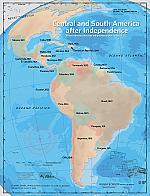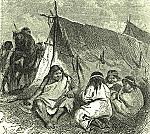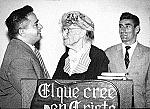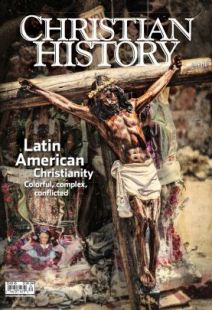Christian History timeline: Latin American Christianity
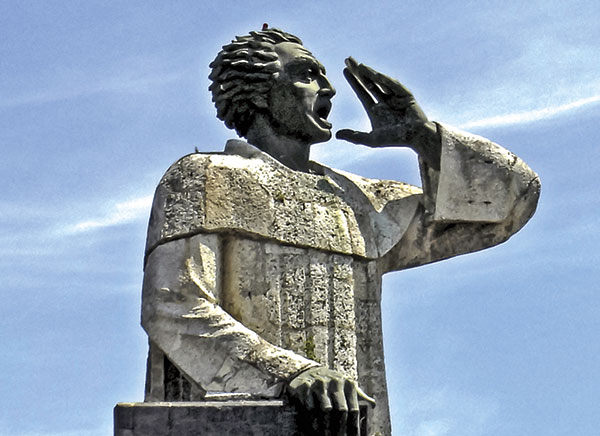
[Antonio de Montesinos shouts against slavery / Wikimeda]
— 1492 Columbus lands on Guanahani, which he renames San Salvador.
— 1493 Papal Bulls of Donation give Portugal and Spain rights in the “New World.”
— 1494 Treaty of Tordesillas divides the “New World” between Spain and Portugal.
— 1502 First Africans arrive as slaves in Haiti.
— 1508 Papal bull Universalis Ecclesiae gives control of the Spanish colonial church to the Spanish crown.
— 1511 Dominican friar Antonio de Montesinos denounces the enslavement of indigenous people.
— 1513 First Catholic diocese is founded in Santo Domingo on the island of Hispaniola.
— 1514 Bartolomé de las Casas begins his defense of the indigenous peoples.
— 1521 Hernán Cortés conquers the Aztecs and renames Tenochtitlán Mexico City.
— 1524 First Franciscan missionaries come to Mexico.
— 1531 Juan Diego Cuauhtlatoatzin sees a vision of the Virgin Mary near Villa de Guadalupe.
— 1532 Conquest of Peru begins.
— 1537 Papal bull Sublimus Dei declares the Indians to be fully human.
— 1542 De las Casas completes A Short Account of the Destruction of the Indies.
— 1551 First Council of Lima organizes the Catholic Church in Latin America.
— 1570 Inquisition begins in Peru.
— 1609 First Jesuit mission is established in Paraguay.
— 1617 Famed mystic and Dominican tertiary Rosa de Lima dies.
— 1619 English settlers bring African slaves to Virginia.
— 1620 Diocese of Buenos Aires founded.
— 1654 Pedro Claver y Corberó, Spanish Jesuit missionary to Colombia, dies. He may have baptized 300,000 slaves.
— 1693 Sor Juana Inés de la Cruz, a Mexican nun, defends a woman’s right to study.
— 1767 Jesuits are expelled from Spanish colonies.
— 1780 Inca leader Túpac Amaru leads an unsuccessful revolt in Peru.
— 1789 Spain opens colonies to all slave traders.
— 1804 Haiti wins independence from France.
— 1810–1824 Spanish colonies revolt and become independent from Spain.
— 1818 James “Diego” Thomson arrives in Buenos Aires.
— 1822 Brazil wins independence from Portugal.
— 1823 US proclaims Monroe Doctrine.
— 1824 Guatemala is first Latin American nation to outlaw slavery.
— 1845 US annexes Republic of Texas.
— 1846–1848 Mexican-American war is fought, reducing Mexico’s territory to the region south of the Rio Grande.
— 1858 Latin American Pontifical College opens in Rome.
— 1888 Brazil abolishes slavery, the final Latin American nation to do so.
— 1890 Pan-American Union is founded (later becoming the Organization of American States).
— 1898 The US takes Puerto Rico and the Philippines in the Spanish-American War.
— 1899 Latin American Plenary Council meets in Rome.
— 1909 Pentecostal revivals begin in Chile.
— 1910 Swedish Pentecostals bring Pentecostalism to Brazil.
— 1913 Committee for Cooperation in Latin America unifies Protestant mission agencies and churches.
— 1914 Panama Canal opens.
— 1926–1929 Government anticlerical policies in Mexico result in the Cristero Rebellion.
— 1929 At the Havana Congress, Protestant denominations speak in favor of “Latinizing” indigenous churches.
— 1946 US Army opens the School of the Americas in Panama to train counterinsurgents. The SOA will be expelled from Latin America in 1984.
— 1949 Latin American Evangelical Conference is held.
— 1956 Five evangelical missionaries are murdered in Ecuador.
— 1959 Cuban Revolution installs Fidel Castro.
— 1962–1965 Vatican II convenes. Chicano movement develops Latino theologies.
— 1967 Argentine revolutionary “Che” Guevara is executed.
— 1968 Latin American Council of Bishops meets in Medellín, Colombia. Paulo Freire publishes Pedagogy of the Oppressed.
— 1969–1972 Jesuit priests spread the Catholic Charismatic movement in Brazil.
— 1971 Gustavo Gutiérrez publishes A Theology of Liberation.
— 1973 Augusto Pinochet assumes power in Chile.
— 1978 John Paul II becomes pope.
— 1979 Sandinista government comes to power in Nicaragua.
— 1980 Salvadoran civil war begins; Archbishop Óscar Romero is assassinated while saying Mass.
— 2013 Jorge Mario Bergoglio, archbishop of Buenos Aires, is selected as first Latin American pope, Pope Francis.
By the editors
[Christian History originally published this article in Christian History Issue #130 in 2019]
Next articles
Central and South America 20th century map
Map of Central and South America in the twentieth century
the editorsStrangers in a strange land
Protestantism and power in nineteenth-century Latin America
Joel Morales Cruz“¡Llegaron los pentecostales!”
How Pentecostalism spread in Latin America and the Caribbean
Carlos F. Cardoza-OrlandiThe delicate balance of church and state in Latin America
The role of religion in Latin America remains strong, and religious voices on all sides can be heard amid current political debates.
Joel Morales CruzSupport us
Christian History Institute (CHI) is a non-profit Pennsylvania corporation founded in 1982. Your donations support the continuation of this ministry
Donate



